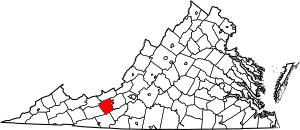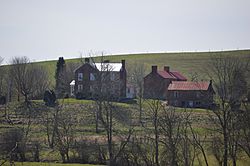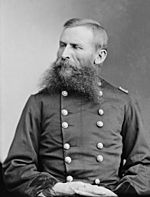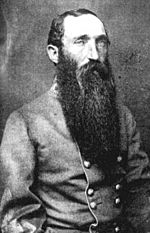Battle of Cloyd's Mountain facts for kids
Quick facts for kids Battle of Cloyd's Mountain |
|||||||
|---|---|---|---|---|---|---|---|
| Part of American Civil War | |||||||
 Pulaski County, location of the Battle of Cloyd's Mountain |
|||||||
|
|||||||
| Belligerents | |||||||
| Commanders and leaders | |||||||
| George Crook Carr B. White Horatio G. Sickel |
Albert G. Jenkins † John McCausland |
||||||
| Strength | |||||||
| 6,100 | 2,400 | ||||||
| Casualties and losses | |||||||
| 688 | 538 | ||||||
The Battle of Cloyd's Mountain was an important Union victory during the American Civil War. It happened in western Virginia on May 9, 1864. This battle allowed Union forces to destroy a big bridge on the Virginia and Tennessee Railroad.
This railroad was very important for the Confederacy. It moved troops and supplies. It also connected the Confederate capital of Richmond with Tennessee. Plus, it had telegraph wires for communication. The battle was very intense, and many soldiers were hurt or killed on both sides. The Confederate commander, Brigadier General Albert G. Jenkins, was badly wounded and later died.
Contents
Why the Battle Happened
Brigadier General George Crook led the Union Army of West Virginia. His army was made up of three groups called brigades. In the spring of 1864, Union General Ulysses S. Grant started a big attack. Several Union armies moved towards Richmond. General Crook's troops were part of this plan.
Crook's main goal was to destroy the Virginia and Tennessee Railroad. This railroad was a vital supply line for the Confederates. It also served important lead and salt mines. Another Union general, William W. Averell, was also working to destroy parts of the same railroad.
The Confederate forces protecting these rail lines were few. Brigadier General Albert G. Jenkins was put in charge of them just one day before Crook's army arrived. Jenkins was an experienced soldier. He had fought in the 1863 Battle of Gettysburg. He was known for leading his men well.
The Battle Unfolds
General Jenkins decided to make a stand at Cloyd's Mountain. He set up a strong defensive position. When General Crook arrived, he saw that a direct attack would be too costly. The area around the mountain was very wooded. Crook used this forest to hide his troops. He planned to move his brigades around to the Confederate right side.
Crook started the battle with a heavy artillery attack. Then, he sent in a brigade of new soldiers from West Virginia. These troops were led by Colonel Carr B. White. Crook's other two brigades were led by Colonel Horatio G. Sickel and Colonel Rutherford B. Hayes. Hayes would later become a U.S. President. Another future U.S. President, William McKinley, was also fighting under Hayes.
White's brigade, fighting for the first time, got very close to the enemy. But they faced heavy fire and had to pull back. Hayes' brigade then led the main attack around 11 a.m. The fighting was very fierce and often hand-to-hand. Sparks from the musket fire set the dry leaves on the ground on fire. Many soldiers were trapped and burned.
Just as the Union brigades started to fall back, Crook sent in fresh troops. The West Virginians finally pushed forward and captured the Confederate artillery. The Ohio troops then began to break through the Confederate center. General Jenkins tried to move his soldiers to stop the attack. But he was severely wounded and captured. His second-in-command, John McCausland, took over. McCausland then led a fighting retreat to save his troops.
The Battle of Cloyd's Mountain happened on the Back Creek Farm. The farmhouse was used as a hospital for the wounded. It also served as General Crook's headquarters.
What Happened Next
The Battle of Cloyd's Mountain was short, lasting just over an hour. Not many troops were involved, but the fighting was very intense. Both sides had a high number of casualties. Crook lost 688 men, which was about 10% of his army. The Confederates lost 538 men, but this was a much larger percentage, about 23% of their total force. General Jenkins died a few days later from his wounds.
The Union won the battle because Crook's forces drove the Confederates away. This allowed Crook to continue his mission. He went on to destroy the important Virginia and Tennessee Railroad depot at Dublin, Virginia. General Averell also destroyed several railroad bridges along the same line. This cut off one of the Confederacy's last vital connections to East Tennessee. The day after the battle, the remaining Confederate troops tried to defend a large railroad bridge over the nearby New River, but they failed.
Union Forces in the Battle
General George Crook commanded the Kanawha Division.
- 1st Brigade — Led by Colonel Rutherford B. Hayes
- 23rd Ohio Infantry
- 36th Ohio Infantry
- Detachment, 34th Ohio Infantry
- 5th West Virginia Cavalry (Dismounted)
- 6th West Virginia Cavalry (Dismounted)
- 2nd Brigade — Led by Colonel Carr B. White
- 12th Ohio Infantry
- 91st Ohio Infantry
- 9th West Virginia Infantry
- 14th West Virginia Infantry
- 3rd Brigade — Led by Colonel Horatio G. Sickel
- 3rd Pennsylvania Reserve Regiment
- 4th Pennsylvania Reserve Regiment
- 11th West Virginia Infantry
- 15th West Virginia Infantry
- Artillery — Led by Captain James R. McMillin
- 1st Ohio Battery
- 1st Kentucky Battery
Confederate Forces in the Battle
General Albert G. Jenkins commanded the Department of Southwestern Virginia. After he was wounded, John McCausland took command.
- 4th Brigade — Led by Colonel John McCausland
- 45th Virginia Infantry
- 60th Virginia Infantry
- 36th Virginia Infantry
- 10th (Diamond's) Kentucky Cavalry (Dismounted)
- 45th Virginia Infantry Battalion
- Home Guards
- Artillery — Led by Captain Thomas A. Bryan
- Botetourt (Va.) Artillery
- Bryan's (Va.) Battery
- Ringgold (Va.) Battery
- Morgan's Brigade — Led by Brigadier General John Hunt Morgan (This brigade arrived late and only helped with the retreat.)
- 5th Kentucky Cavalry
Images for kids








